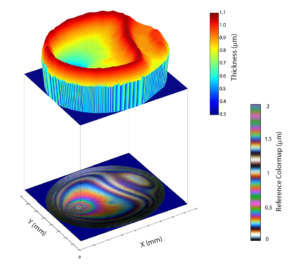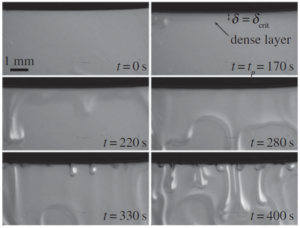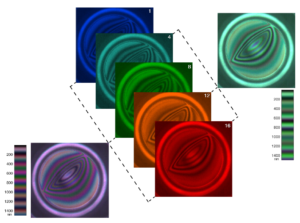Doctoral Candidate
Trivandrum, India
Education
M.S. Chemical Engineering, École Polytechnique, France
Research Focus:
A. Bubble Dynamics
Bubbles and aggregates of bubbles in the form of foams are ubiquitous in nature. As part of my PhD, I am exploring the dynamics of bubbles in the following contexts:
(i) Bubble and foam stability in lubricant base oils
Entrainment of bubbles and the consequent formation of stable foam in lubricants is detrimental for the lubricated machinery. Hence, to help mitigate foaming in lubricants, using a previously reported single bubble technique we are investigating the physical mechanisms stabilizing foams in lubricants.  Fig: The experimental setup. a,b. The various parts of the setup. c. An example of the spatio-temporal measurement of the bubble wall thickness in a Group I lubricant.
Fig: The experimental setup. a,b. The various parts of the setup. c. An example of the spatio-temporal measurement of the bubble wall thickness in a Group I lubricant.
Current Results: Our experiments indicate that solutocapillary Marangoni flows resulting from the differential evaporation of the various components of a lubricant, promote lubricant foaming. This novel finding underscores the importance of minimizing lubricant base oil mixing during lubricant formulation.
Future work: A common way for destroying foams is by using special additives called as anti-foams. Using a combination of experiments and theory we are currently investigating the mechanism of antifoam action in non-aqueous foams.
![]() Chandran Suja, V., et al. “Evaporation-induced foam stabilization in lubricating oils.” Proceedings of the National Academy of Sciences 115.31 (2018): 7919-7924.
Chandran Suja, V., et al. “Evaporation-induced foam stabilization in lubricating oils.” Proceedings of the National Academy of Sciences 115.31 (2018): 7919-7924.
(ii) Symmetry breaking and chaos in evaporation driven Marangoni flows over bubbles
Evaporation driven Marangoni flows play a dominant role in stabilizing non-aqueous bubbles and foams in systems with a volatile component. Using blends of silicone oils are model systems, we investigated the fundamental characteristics of these flows.
Fig: Interferograms obtained over bubbles in blends of silicone oils with different concentration (volume percentage) of the volatile species.
Current Results: The radial symmetry and temporal stochasticity of evaporation driven Marangoni flows are non-monotonic functions of the volatile species concentration, with the flows being radially symmetric and temporally periodic at very low and very high concentrations. At intermediate concentrations (eg. 50%), the power spectrum of thickness fluctuations obey the famed Kolmogrov -5/3rd scaling.
Future work: The developed experimental protocols offer a convenient framework to study a number of problems in 2D forced turbulence.
![]()
![]() Chandran Suja, V., et al. “Symmetry breaking and chaos in evaporation driven Marangoni flows over bubbles.” arXiv preprint arXiv:2004.09752.
Chandran Suja, V., et al. “Symmetry breaking and chaos in evaporation driven Marangoni flows over bubbles.” arXiv preprint arXiv:2004.09752.
(ii) Expansion and contraction dynamics of bubbles on capillaries
The expansion and contraction of bubbles in capillaries are common in many industrial settings and experimental setups, for instance as shown above in the DFI. Using a combination of experiments and theory we investigated the shapes of expanding and contracting bubbles. Fig: Experimentally obtained outline of bubbles quasi-statically expanding on capillaries demonstrating the bubble shape hysteresis. a. Subcritical case – the bubble can access all the equilibrium shapes b. Supercritical case – the bubble cannot access regions that are white in color.
Fig: Experimentally obtained outline of bubbles quasi-statically expanding on capillaries demonstrating the bubble shape hysteresis. a. Subcritical case – the bubble can access all the equilibrium shapes b. Supercritical case – the bubble cannot access regions that are white in color.
Current results: A quasi-static analysis of the bubbles expanding and contracting capillaries revealed that the bubble shapes exhibit hysteresis. We have termed this novel hysteretic phenomenon as the “bubble shape hysteresis” – the details of which can be found in the paper below.
Future work: The bubble shape hysteresis is a consequence of a cusp bifurcation in the equilibrium shapes of bubbles. Interestingly, by tuning the parameters of the system and operating the bubble close to onset of the bifurcation, we can vastly amplify the expansion/contraction rate of the bubble relative to the forcing. We are interested in understanding this phenomenon in more detail and finding applications for the same.
![]() Chandran Suja, V., Frostad, J. M., & Fuller, G. G. (2016). Impact of Compressibility on the Control of Bubble-Pressure Tensiometers. Langmuir, 32(46), 12031-12038.
Chandran Suja, V., Frostad, J. M., & Fuller, G. G. (2016). Impact of Compressibility on the Control of Bubble-Pressure Tensiometers. Langmuir, 32(46), 12031-12038.
(iii) Coalescence of bubbles in worm like micelles
A majority of liquids in which bubbles are commonly found are viscoelastic in nature. We are currently investigating experimentally and theoretically the coalescence of bubbles in model viscoelastic worm like micellar liquids.
Current results: As shown in the video above, our preliminary experiments revealed that bubble coalescence in worm like micellar solutions are intrinsically different from that in traditional surfactant solutions. Notably, in certain worm like micelles, we observed the elastic recoils of dimples that are formed on the bubbles.
Future work: A comprehensive understanding of bubble coalescence in worm like micellar fluids.
B. Interaction of soft deformable materials
Interaction of soft deformable materials are prevalent in industrial and biological settings. As part of my PhD, I am exploring this topic in the following contexts:
(i) Antifoaming performance of filtered lubricants
A common method for tackling foaming is through the use of antifoams. When lubricants containing antifoams are filtered there can be dramatic degradation in the foaming performance of the lubricant. 
Fig: An interogram and its reconstruction showing an antifoam in the process of rupture a bubble.
Current Results: The foam stability in filtered lubricants is directly correlated to the number of filtration cycle, and inversely correlated to filter pore size and the initial antifoam concentration.
Future work: We are working on validating a probabilistic model that provides an estimate of the antifoam size distribution given a distribution of bubble life times in a lubricant. Additional venues for future research include the role of filter poroelasticity in dictating the size distribution of antifoams in a filtered lubricant.
![]()
![]() Chandran Suja, V., et al. “Foam stability in filtered lubricants containing antifoams.” Journal of Colloid and Interface Science 567 (2020): 1-9.
Chandran Suja, V., et al. “Foam stability in filtered lubricants containing antifoams.” Journal of Colloid and Interface Science 567 (2020): 1-9.
C. Drying of polymer solutions
Polymer solutions are common in many industrial processes and formulations. These solutions may be inadvertenly exposed to ambient triggering the process of drying or is intended to be used in their dried form as with paints and inks. As part of my PhD, I am exploring this important topic in the following contexts:
(i) Evaporation induced Rayleigh-Taylor instabilities (in collaboration with E. M. Mossige)
Evaporation can trigger hydrodynamic instabilities in polymer solutions. Fig: Sequence of images showing the evaporation driven Rayleigh-Taylor instability in an aqueous Dextran solution.
Fig: Sequence of images showing the evaporation driven Rayleigh-Taylor instability in an aqueous Dextran solution.
Current Results: The onset time of the instability scales as (ν/c0)2/3 for high diffusivity polymers at all concentration. For polymers with low diffusivity, we observed a deviation from this scaling below a critical concentration, with the onset scaling as c0-1 .
Future work: A number of interesting extensions of this work exist including evaluating the influence of interfacial rheology on the instability.
![]() Mossige, E. J.*, Chandran Suja, V.*, et al. “Evaporation Induced Rayleigh-Taylor Instabilities in Polymer Solutions.” arXiv preprint arXiv:2002.08515 (2020). * Equal contribution.
Mossige, E. J.*, Chandran Suja, V.*, et al. “Evaporation Induced Rayleigh-Taylor Instabilities in Polymer Solutions.” arXiv preprint arXiv:2002.08515 (2020). * Equal contribution.
(ii) Shape instabilities in drying polymer drops(in collaboration with J. Belanger)
Polymer drops containing PEG or Dextran is known to display topological instabilities. Fig: Final drop profiles after drying for PEG droplets with varying initial concentration of the polymer.
Fig: Final drop profiles after drying for PEG droplets with varying initial concentration of the polymer.
Current Results: The topological instability is triggered above a critical concentration that is a function of the polymer molecular weight, substrate properties and ambient conditions.
Future work: We are currently working on understanding the physical mechanism responsible for the observed topological shape instabilities.
D. Tear film mechanics over contact lenses
Contact lenses can alter the tear film stability, leading to poor vision quality and discomfort. As part of my PhD, I am exploring this topic in the following contexts:
(i) Hyperspectral imaging for thin film visualization
Automated high throughput mapping of thicknesses of thin films is crucial for translating many experimental protocols for studying tear films from the lab to the clinic.
Fig: Interference patterns on a bubble visualized by a snapshot hyper-spectral imager.
Current Results: We successfully demonstrated the technology for reconstructing thickness of bubbles in silicone oils.
Future work: Current work is aimed at improving the robustness of the technique to automatically process tear film interferograms through a combination of optimization routines and machine learning.
![]() Chandran Suja, V., et al. “Hyperspectral imaging for dynamic thin film interferometry” under review in Sci. Rep
Chandran Suja, V., et al. “Hyperspectral imaging for dynamic thin film interferometry” under review in Sci. Rep
(ii) In-vivo tear film visualization
High fidelity spatio-temporal visualization of the tear film is crucial for diagnosing many ocular disorders as well could one day improve contact lens prescriptions. Fig: In-vivo visualization of the tear film over a contact lens utilizing thin film interferometry
Fig: In-vivo visualization of the tear film over a contact lens utilizing thin film interferometry
Current Results: We have spatio-temporal characteristics of tear films over different contact lenses in-vivo as a function of contact lens type and duration of contact lens wear.
Future work: Current work is aimed at establishing correlations between the measured spatio-temporal tear film characteristics and contact lens comfort.
(iii) Dewetting of in-vitro model tear films over contact lenses (in collaboration with E. M. Mossige)
Using a previously reported setup, we are investigating how surface modification on contact lenses alter the dewetting characteristics of model tear films over contact lenses. Fig: Visualization of a model tear film over a contact lens with a zwitterionic coating
Fig: Visualization of a model tear film over a contact lens with a zwitterionic coating
Current Results: We have experimentally characterized a number of contact lenses with different surface modifications.
Future work: Current work is aimed at establishing correlations between the measured dewetting characterisitcs and properties such as the dynamic contact angle.
